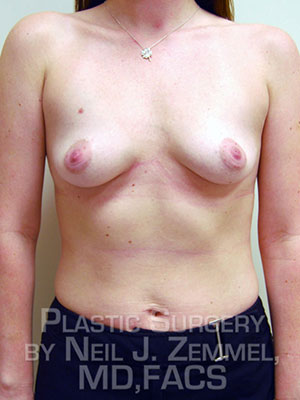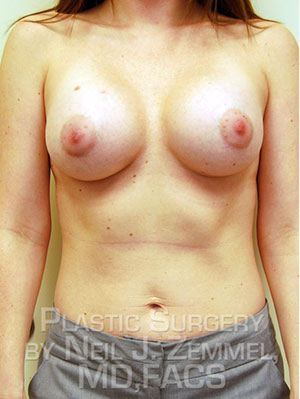Common Concerns
At Richmond Aesthetic Surgery, our goal is to give you the personalized attention you deserve and help you achieve the surgical outcome you envision. Our board-certified plastic surgeon, Dr. Neil J. Zemmel, takes the time to get to know each of his patients’ individual aspirations and concerns and works with you to design a custom-tailored approach for your breast augmentation, breast lift, or breast reconstruction. On this page, our surgeon has gathered the most frequently cited reasons his patients have sought breast surgery over his many years of experience. Familiarizing yourself with these common concerns will enable you to better articulate your surgical goals during your one-on-one breast surgery consultation, clearly communicate your expectations, and may ultimately lead to increased satisfaction with your results and your new figure.
- Small Breasts
- Breast Abnormalities
- Breast Implant-Related Problems
- Breast Augmentation in African American, Latin-American, and Asian Women
Small Breasts
The most frequent reason women seek out breast augmentation is because they desire an increase in breast size and fuller breast volume. Balancing the proportion of the breasts with the rest of the body is a vital component of creating the natural and pleasing aesthetic our surgeon aims to help each patient obtain. For patients with breasts that are small in proportion to the rest of their figure, breast augmentation with breast implants can provide a more harmonious overall appearance. Some women feel very self-conscious about the size of their breasts, and for these patients, fuller breasts often have the added benefit of boosting confidence. Our surgeon will ascertain your goals for your breast surgery, and will work with you to select a breast implant size and shape that will complement the rest of your figure. He will maintain the most natural look and feel for your breast augmentation.
Breast Abnormalities
The desire to correct breast abnormalities is another common reason women seek cosmetic breast surgery. There are a number of conditions that can detract from a balanced, well-proportioned, and harmonious breast shape. Our surgeon can address many of these conditions with advanced techniques designed to renew the appearance of your breasts. Some conditions women seek to correct include:
- Breast Asymmetry: Most women are not born with perfectly symmetric breasts, but in some women, discrepancies in breast size and/or shape may be more extreme and cause the breasts to look uneven.
- Large Areola Size: Some women have an areola diameter that is disproportionate with their overall breast size, while other women have one breast with a significantly larger areola diameter than the other.
- Tubular Breast (Constricted Breasts): Tubular or constricted breasts are breasts that have an underdeveloped lower hemisphere, causing the breast to appear narrower or tighter along the breast’s base and preventing a full round shape. Oftentimes, the areola can be larger and the breasts can have an overall conical shape. A breast lift is often used in conjunction with implants to address this concern.
- Sagging Breasts (Breast Ptosis): There are many reasons why the breasts may appear to sag, but regardless of the cause, our surgeon can help replenish lost volume, eliminate excess skin, and restore the breasts to a more youthful position.
- Breast Volume Deflation: After pregnancy or with age, a certain degree of volume loss is natural. As more volume is lost, the breasts will continue to sag and appear deflated.
- Post Pregnancy: During pregnancy, the breasts naturally become fuller. However, after pregnancy and breast-feeding, the breasts may not regain their pre-pregnancy shape or size.
- After Major Weight Loss: Dramatic weight loss – whether from rigorous dieting and exercise or from bariatric surgery – can leave excess skin surrounding the breasts as well as a breast volume that is now out of proportion with your new, slimmer figure.
- Absence of the Breast: Choosing to undergo breast reconstruction after a mastectomy due to cancer or other condition is an especially personal and important decision. Our surgeon will use his expertise to help you recreate a breast that looks and feels natural. Breast reconstruction can be performed with an implant or with your body’s own tissue (also known as fat transfer), depending upon your goals and unique needs.
Learn More About Breast Reconstruction
Breast Implant-Related Problems
Your health and safety are the most important considerations before, during, and after your breast surgery. Dr. Zemmel performs all breast surgery procedures in a fully accredited operating room at either St. Francis Hospital in Midlothian, Virginia, St. Mary’s Hospital in Richmond, or at Henrico Doctor’s Hospital in Richmond’s West End. In addition, Board Certified Anesthesiologists and Board Certified Registered Nurse Anesthetists will help ensure your comfort and safety during the procedure. This setting is designed to maximize the quality of your results while simultaneously minimizing risks of complications. However, there are some complications associated with breast surgery that can arise no matter how much one prepares for them. Our surgeon will provide a thorough overview of the risks involved with breast surgery during the consultation process, and he is trained to proactively address all of these complications, should they occur. Some of these rare complications include:
- Capsular Contracture: Capsular contracture is the term used to describe scar tissue that has hardened around a breast implant, and occurs in less than 2% of our surgeon’s patients. To minimize the risk of this complication, Dr. Zemmel utilizes the no-touch Keller Funnel technique, which involves placing the implants through a special cone-shaped tool. This device allows for a safer, more efficient implant placement. The skin never makes contact with the implant, helping prevent the transfer of bacteria and possible infection. This has also shown to reduce the risk of biofilm formation, which is a type of bacteria believed to cause chronic wounds.
- Silicone Implant Rupture: A silicone implant rupture occurs when the wall of the implant tears. Because the newer generation silicone implants contain a cohesive silicone gel, there is no leakage of gel from the inside of the implant. There is an extremely low risk of the gel migrating from the implant and breast pocket. This type of rupture can be detected on routine surveillance imaging after breast augmentation with silicone implants.
- Saline Implant Deflation: Saline implant deflation occurs when the wall of the implant is breached and the liquid saline leaks from the implant wall. This type of rupture is often easily detectable, as the shape of the breast will typically change rapidly. The saline is completely harmless and is easily absorbed by the body. Both silicone and saline implant rupture are easily correctable with an implant exchange operation.
- Asymmetric Breast Implants: Occasionally, as the body heals and post-surgical swelling diminishes, one breast may appear larger than the other.
- Implant Malposition: In some cases, while the body heals from surgery, the breasts may settle in slightly different positions on the chest wall. There are a number of ways in which implant malposition can manifest, such as:
- Symmastia: when the breast implants look like a single structure across the chest wall without any significant cleavage separating the breasts. This is also known as “uniboob.”
- Lateral Subluxation: when one or both implants move or have permanently moved laterally toward the side/sides of the body towards to the underarm area.
- Inferior Malposition (bottoming out): when the lower pole of one or both implants descends below the intended position on the chest wall giving the appearance of a lower breast and higher nipple.
- Superior Malposition: when the upper pole of one or both implants ascends above the intended position on the chest wall
- Breast Implant Rippling: Particularly with patients who are slimmer or have thin skin and thin soft tissue over the implant, the skin and tissue surrounding the implant may ripple or wrinkle.
- Suboptimal Cosmetic Outcome: Sometimes, in spite of a thorough consultation process and customized surgical approach, patients are unhappy with their new look.
- Disproportionate Implant: In rare cases, the final implant selection looks disproportionate with the rest of the body after the healing process is complete.
Breast Augmentation in African American, Latin-American, and Asian Women
In recent years, according to the American Society of Plastic Surgeons, there has been a significant increase in the number of African-American Women, Asian-American Women, and Latin-American Women seeking plastic surgery. From his personal experience, Dr. Zemmel understands that these women have some unique concerns about breast surgery.
- Breast Shape: Dr. Zemmel understands that women from different ethnic backgrounds may have differing cosmetic goals. Our surgeon tailors each procedure to the individual patient; therefore, he will vary the breast surgery technique to accommodate patients of all ethnic backgrounds.
- Post-Operative Scarring: Since it is more likely that women of these ethnicities will develop scars with a dark pigment, patients are often more concerned with the placement and final appearance of scars after surgery. Though hypertrophic scars (formed along the surgical incision) and keloid scars (formed beyond the border of the incision) are rare, Dr. Zemmel is trained to carefully conceal the surgical incisions and also address their appearance, should they arise. Our surgeon will prescribe a custom-compounded scar cream for all post-operative patients. This will help reduce the risk of developing a hypertrophic scar after surgery. Patients who have a history of true keloid scars may not be ideal candidates for breast surgery, and should discuss this condition during the consultation process.
Contact Us
If you have further questions or concerns about breast augmentation, breast lift, or breast reconstruction surgery, please contact our office today to schedule a consultation.



